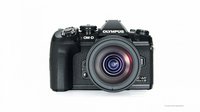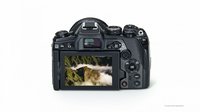Olympus OM-D E-M1 Mark III Mirrorless
MFT CameraProduct Gallery



Product Overview
Olympus OM-D E-M1 Mark III is a high-end mirrorless camera in the Micro Four Thirds-mount system. Introduced by Olympus in 2020, it comes with a micro four thirds sensor with 20 MP (5184 x 3888) resolution and a 2.36 million-dot EVF.
The camera has a usable battery life, though a second battery may be a good thing to keep in your camera bag. One should note that the OM-D E-M1 Mark III has a 200 base ISO, which is not conducive to getting the cleanest images. Professionals and fanboys will be pleased by the extraordinary 60.0 fps burst rate that this camera can deliver.
The E-M1 Mark III comes with a fully articulated touch display and 121 autofocus points. Those who intend to use the camera for video work will be glad to find that the camera comes with 7 stops of IBIS.
Ratings
What we found
Neofiliac score 63%
Pros
- Fully articulated LCD
- 7 stops of IBIS
- Extraordinary 60.0 fps burst rate
- Weather-sealed
- Viewfinder with great 1.48x magnification
- Supports both WiFi and Bluetooth
Cons
- 200 base ISO
- Low 20 MP resolution
- Low resolution EVF
What external reviewers found
External score 71%
Pros
- Excellent image stabilization
- Built-in weather protection and weather protection
- Dust and splash protection
- Weather-sealed sensor
- Svelte f/1.8 and f/2.8 prime lenses
Cons
- Metering system feels inconsistent
- Mediocre viewfinder resolution
- No telephoto zoom
- Larger sensor
Your rating:
12345678910
?/10
Price Comparison
As associates of the merchants above, we earn a commission when you make a purchase using the supplied links.
Specifications
[{"Ft":"Connectivity","Fn":"Ports","Fv":"HDMI + Headphone + Microphone + Remote Control + USB 3.2 Gen 1"},{"Ft":"Connectivity","Fn":"Wireless Connectivity","Fv":"802.11ac + Bluetooth"},{"Ft":"Construction","Fn":"Form Factor","Fv":"Mirrorless camera"},{"Ft":"Construction","Fn":"Image Size","Fv":"Four Thirds (17.4 x 13 mm)"},{"Ft":"Construction","Fn":"Lens Mount","Fv":"Micro Four Thirds-mount"},{"Ft":"Construction","Fn":"Microphone","Fv":"Stereo"},{"Ft":"Construction","Fn":"Sensor | Resolution","Fv":"20 MP (5184 x 3888)"},{"Ft":"Construction","Fn":"Sensor | Type","Fv":"CMOS"},{"Ft":"Construction","Fn":"Speakers","Fv":"Mono"},{"Ft":"Dimensions","Fn":"Size | Depth","Fv":"69 mm / 2.72 in"},{"Ft":"Dimensions","Fn":"Size | Height","Fv":"91 mm / 3.58 in"},{"Ft":"Dimensions","Fn":"Size | Width","Fv":"134 mm / 5.28 in"},{"Ft":"Dimensions","Fn":"Weight","Fv":"580 g / 20.49 oz"},{"Ft":"Display","Fn":"Display Diagonal","Fv":"3 inch"},{"Ft":"Display","Fn":"Display Type","Fv":"Fully articulated TFT LCD"},{"Ft":"Display","Fn":"Resolution","Fv":"1,037,000 dots"},{"Ft":"Display","Fn":"Viewfinder | Coverage","Fv":"100%"},{"Ft":"Display","Fn":"Viewfinder | Magnification","Fv":"1.48x"},{"Ft":"Display","Fn":"Viewfinder | Resolution","Fv":"2,360,000 dots"},{"Ft":"Display","Fn":"Viewfinder | Type","Fv":"Electronic"},{"Ft":"Function","Fn":"AE Bracketing","Fv":"(2, 3, 5, 7 frames at 1/3 EV, 2/3 EV, 1 EV steps)"},{"Ft":"Function","Fn":"Autofocus","Fv":"121 focus points"},{"Ft":"Function","Fn":"Crop Factor","Fv":"2.0"},{"Ft":"Function","Fn":"Exposure Compensation","Fv":"±5 (at 1/3 EV, 1/2 EV, 1 EV steps)"},{"Ft":"Function","Fn":"Exposure Mode","Fv":"Auto / Aperture Priority / Shutter Priority / Manual"},{"Ft":"Function","Fn":"GPS","Fv":"No"},{"Ft":"Function","Fn":"ISO Range","Fv":"200 ~ 25600 (expands to 64 ~ 25600)"},{"Ft":"Function","Fn":"Image Stabilization","Fv":"7 stops body-only (7.5 stops with 12-100mm F4 lens), 7 stops"},{"Ft":"Function","Fn":"Intervalometer","Fv":"Yes"},{"Ft":"Function","Fn":"Processor","Fv":"TruePic IX"},{"Ft":"Function","Fn":"Touch Screen","Fv":"Yes"},{"Ft":"Function","Fn":"Video Codecs","Fv":"MPEG-4, H.264"},{"Ft":"Function","Fn":"Weather Resistance","Fv":"Yes"},{"Ft":"Performance","Fn":"Battery Life","Fv":"420 shots"},{"Ft":"Performance","Fn":"Max Burst Rate","Fv":"60.0 fps"},{"Ft":"Performance","Fn":"Shutter Speed","Fv":"1/32000 s (electronic) / 1/8000 s (mechanical) ~ 60 s"},{"Ft":"Performance","Fn":"Storage","Fv":"Dual SD/SDHC/SDXC slots (UHS-II on first slot)"},{"Ft":"Production","Fn":"Battery","Fv":"BLH-1 lithium-ion battery \u0026amp; charger"},{"Ft":"Production","Fn":"Debut","Fv":"2020-02-12"}]
External Reviews
digitaltrends[1]
Reviewer score 71% (normalized by Neofiliac)The E-M1 Mark III houses the same sensor as the Mark II, with the same 20MP resolution. A new detail priority mode processes high ISO images twice, slowing the camera but increasing the level of detail. The viewfinder resolution is a couple of generations out of date, and the metering system feels inconsistent.
Pros
- Excellent image stabilization
- Weather-sealed sensor
- Dust and splash protection
- 2X crop factor
Cons
- Mediocre viewfinder resolution
- Metering system feels inconsistent
pcmag[2]
Reviewer score 71% (normalized by Neofiliac)Olympus has made its best Micro Four Thirds camera, but it's telling that upgrades from the aging Mark II are not earth shattering. If you're after the shallow depth of field look, you are almost certainly better off with a system built around a larger sensor. The E-M1 Mark III doesn't offer any palpable video updates.
Pros
- Svelte f/1.8 and f/2.8 prime lenses
- Excellent image stabilization
- Built-in weather protection and weather protection
Cons
- Larger sensor
- No telephoto zoom
Also Check
References
<
>
x